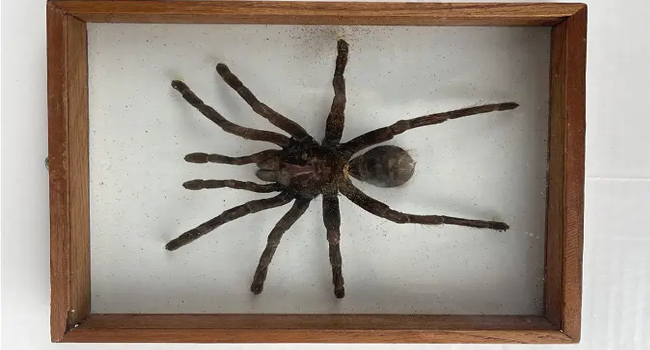Introduction
Tarantula taxidermy is an intricate and fascinating art that involves preserving the beauty of these remarkable creatures. In the world of tarantula taxidermy, its history, techniques, and the significance of protecting these creatures. Join us as we delve into the realm of arachnid artistry.
The History of Tarantula Taxidermy
Tarantula taxidermy is an ancient practice dating back centuries. Historically, tarantulas were revered for their symbolism and the perceived medicinal properties of their venom. In this section, we’ll uncover the historical significance of tarantulas in various cultures and their use in traditional medicine.
The Importance of Tarantula Conservation
With the growing concerns of tarantula populations facing threats from habitat destruction and the pet trade, it’s crucial to discuss the significance of tarantula conservation efforts. This section will highlight the importance of preserving these arachnids in their natural habitats.
The Artistry of Tarantula Taxidermy
Tarantula taxidermy is more than just preservation; it’s an art form. In this part of the article, we will explore the artistic aspects of tarantula taxidermy, the different techniques used, and the tools required.
Selecting the Right Specimen
Choosing the right tarantula specimen is an essential first step in the taxidermy process. We’ll discuss factors like size, species, and condition when selecting a tarantula for preservation.
Preparing the Specimen
This section delves into the preparation process, from removing the internal organs to cleaning and drying the tarantula. It’s a delicate and precise procedure that requires patience and skill.
Mounting and Positioning
Positioning the tarantula is where the artistry comes into play. We will explore different poses and mounting techniques that showcase the tarantula’s beauty and unique features.
The Tools of the Trade
In this section, we’ll introduce the various tools and materials used by tarantula taxidermists, from pins and needles to preserving chemicals and display cases.
Ethical Considerations
Tarantula taxidermy raises ethical questions about the treatment of these creatures. We will discuss the responsible and ethical practices that should be followed, such as sourcing specimens sustainably.
The Role of Tarantula Taxidermy in Education
Tarantula taxidermy can be an educational tool, allowing people to learn about these magnificent creatures up close. This part of the article will explore how tarantula taxidermy contributes to science and education.
Preserving Beauty for Generations
Tarantula taxidermy is a way to immortalize these creatures and preserve their beauty for future generations to appreciate. In this section, we’ll emphasize the longevity and value of well-executed tarantula taxidermy.
The Cultural Significance of Tarantula
Throughout history, tarantulas have held a special place in various cultures. In this section, we’ll explore the cultural significance of these arachnids and how tarantula taxidermy has been a part of human traditions.
Ancient Beliefs and Symbolism
In many ancient cultures, tarantulas were associated with various beliefs and symbolism. They were often linked to protection, fertility, and spiritual significance. Preserving them through taxidermy was seen as a way to retain their mystical powers.
Traditional Medicine
Some cultures believed that tarantula venom had medicinal properties. Tarantula taxidermy was practiced to harness these alleged healing powers. Today, such practices are considered superstitious, but they offer a glimpse into the historical importance of these creatures.
Modern Appreciation
In the modern world, tarantulas are admired for their striking appearance and the curiosity they spark. Tarantula taxidermy allows enthusiasts to appreciate their beauty without needing live specimens.
The Intersection of Science and Art
Tarantula taxidermy is a captivating blend of science and artistry. It serves as a bridge between these two worlds, contributing to both fields in various ways.
Scientific Research
Well-preserved tarantula specimens are invaluable in scientific research. They provide a stable reference for studying the physical characteristics, behavior, and evolutionary aspects of these arachnids. Taxidermy plays a vital role in advancing our understanding of tarantulas.
Artistic Expression
The artistry of tarantula taxidermy is evident in the lifelike poses and meticulous attention to detail. Taxidermists express their creativity and passion through their work, creating stunning pieces that capture the essence of these creatures.
Conservation Education
Tarantula taxidermy can be a powerful tool in educating the public about the importance of tarantula conservation. Displaying well-preserved specimens can raise awareness and inspire people to support efforts to protect these creatures and their habitats.
Durability
Well-preserved tarantulas can last many years, even decades, if kept in suitable conditions. The durability of taxidermy specimens allows enthusiasts to appreciate the beauty of these creatures for a significant portion of their lives.
Educational Value
Taxidermy specimens serve as valuable tools for education. Schools, museums, and nature centers often use these preserved tarantulas to educate the public about arachnids, their ecological roles, and the importance of conservation
A Glimpse into the Past
Preserved tarantulas offer us a window into the past. Many antique tarantula taxidermy pieces have historical significance and are sought after by collectors. These specimens provide a glimpse into the tarantula taxidermy practices of bygone eras.
The Future of Tarantula Taxidermy
As tarantula taxidermy gains recognition and appreciation, its future looks promising. The art form continues to evolve, driven by technological advancements, ethical considerations, and a growing community of enthusiasts.
Technological Advancements
Advancements in preservation techniques and materials have made tarantula taxidermy more accessible and environmentally friendly. These innovations ensure that the art form can adapt to changing times.
Ethical and Sustainable Practices
The importance of ethical sourcing and sustainable preservation practices cannot be overstated. The future of tarantula taxidermy depends on the responsible treatment of both live specimens and their preserved counterparts.
Community Growth
The Tarantula taxidermy community is growing, with enthusiasts and professionals sharing their knowledge, experiences, and innovations. This communal spirit ensures that the art form will continue to flourish.
Displaying well-preserved tarantulas is an essential part of tarantula taxidermy. How these arachnids are showcased can significantly impact the viewer’s experience and appreciation of their beauty.
Shadow Boxes
One standard method of display is the use of shadow boxes. These boxes provide a protective environment for the tarantula while allowing it to be easily observed. Taxidermists often arrange their specimens in aesthetically pleasing compositions within these boxes.
Glass Display Cases
For more extensive collections or individual masterpieces, glass display cases are prevalent. These cases not only protect the tarantulas from dust and physical damage but also allow for an unobstructed view, preserving the specimens’ lifelike appearance.
Artistic Arrangements
Many taxidermists go beyond the conventional and create artistic arrangements, often adding natural elements like branches, leaves, or other insect specimens to enhance the display’s visual appeal.
Raising Awareness
By showcasing tarantulas in lifelike poses, taxidermy helps raise awareness about these creatures’ ecological significance. It highlights the unique beauty of each species, encouraging people to appreciate and protect them in the wild.
Scientific Study
Preserved tarantulas serve as valuable references for scientific research. Researchers can study the specimens to gain insights into tarantula biology, behavior, and evolutionary history. Taxidermy contributes to our understanding of these creatures.
Ethical Preservation
Responsible taxidermists play a part in ethical preservation by advocating for sustainable practices, ethical sourcing, and legal compliance. This ensures that the art form contributes positively to conserving tarantulas and their natural habitats.
In Conclusion
Tarantula taxidermy is a remarkable intersection of art, science, and conservation. It offers a unique opportunity to appreciate the beauty of these arachnids while contributing to their protection. By following ethical practices and responsible preservation methods, we can ensure that future generations continue to be inspired by the mesmerizing world of tarantulas.
Whether you’re a seasoned taxidermist or a curious beginner, the art of tarantula taxidermy holds endless possibilities for exploration and discovery. Join the community, learn the techniques, and be part of a movement dedicated to preserving the beauty of these incredible creatures.







